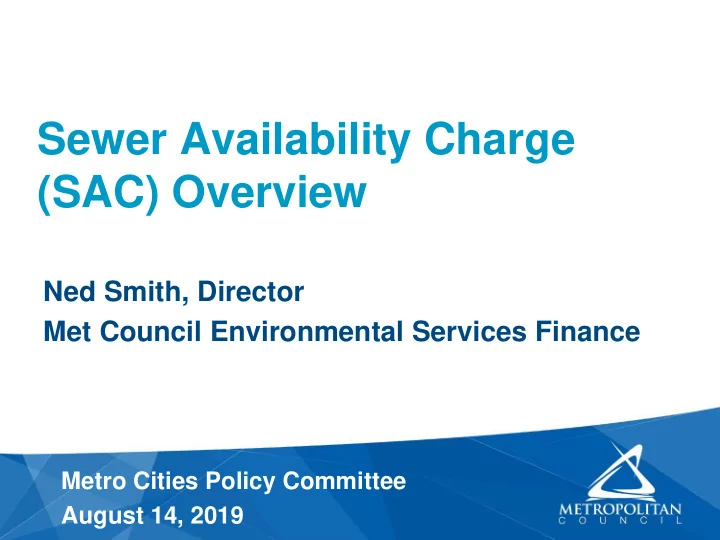

Sewer Availability Charge (SAC) Overview Ned Smith, Director Met Council Environmental Services Finance Metro Cities Policy Committee August 14, 2019
Wastewater Treatment Service Area and Facilities We serve ~50% of Minnesota’s population Service Areas Blue Lake Eagles Point WHO WE SERVE East Bethel Crow 7 -county Twin Cities Metro Area River Empire 110 communities Hastings 3,000 square miles Metro Seneca 2,600,000+ people St. Croix Valley Crow River OUR FACILITIES Interceptors 9 wastewater treatment plants 610 miles of interceptors 61 pump stations 250 million gallons per day (avg) OUR ORGANIZATION 600+ employees $7 billion in valued assets $140 million per year capital program $311 million annual operating budget 25
What is SAC? • The Sewer Availability Charge, or SAC, is a one-time fee charged to local governments for new or increased capacity demand on the system • One single family home = 1 SAC unit • Non-residential properties require a determination (or calculation) of the maximum potential wastewater capacity needed for the site. • The Council charges SAC to local governments, who pass it on to business or property owners. • Capacity demand is not the same as flow 26
SAC is about providing capacity for the busiest day of the year Consider TCF Stadium: • Capacity (pipe size) needed for average flow VS. • Capacity needed during a Gophers-Badger game Result: 526 SAC Average Flow Gophers- Badgers game 27
SAC is a critical revenue source Other Industrial 5% • A material component Charge 5% of waste water fees • Elimination would SAC increase monthly 15% ($44M) sewer fees by ~20% • Accrued benefits over 45 years Monthly Wastewater Charge 75% Sources (2019 Budget)
2016-2017 SAC Task Force • Comprised of 14 representatives from customer communities and businesses, including Metro Cities • Focused on reviewing: – Outdoor seating policy – maintain but with higher “free” seats due to new determination process – Options for manufactured homes – maintain but monitor flow data and encourage grants – Opportunities to simplify SAC Determination process – Opportunities to simplify SAC Credit process 29
SAC Determination Process • Revise the SAC Determination process – Utilize gross square feet of tenant space versus net square feet of individual usage to calculate SAC – Combine certain categories to further simplify the process Old New 30
No-Change-of-Use Remodel Determinations • Businesses that remodel without changing their use face no additional SAC collection – MCES needs to verify that no change of use has occurred by completing a SAC Determination – Renovations should have fewer “surprise” charges 31
SAC Credit process • Prior date for grandparent credit was January 1, 1973 • Grandparent date is now January 1, 2009 – If there is no record of a previous SAC determination, proof of usage prior to January 1, 2009 is all that is needed to establish the base credit • Credits will be issued based on revised criteria 32
How’s it going? • My phone doesn’t ring • Outreach feedback was overwhelmingly positive – Feedback included extensive city training, small business groups, development groups, etc. • 12 months in, commercial SAC is down ~4% YoY – Predicted 2-4%, but 2018 was down more (13%) – Asking TKDA to assess if decline is due to criteria/credit change 33
What else can cities do? • Ask for training from Met Council • Convene small business outreach (we do road shows!) • Sign up for the SAC Deferral $ program 34
Questions?
Recommend
More recommend